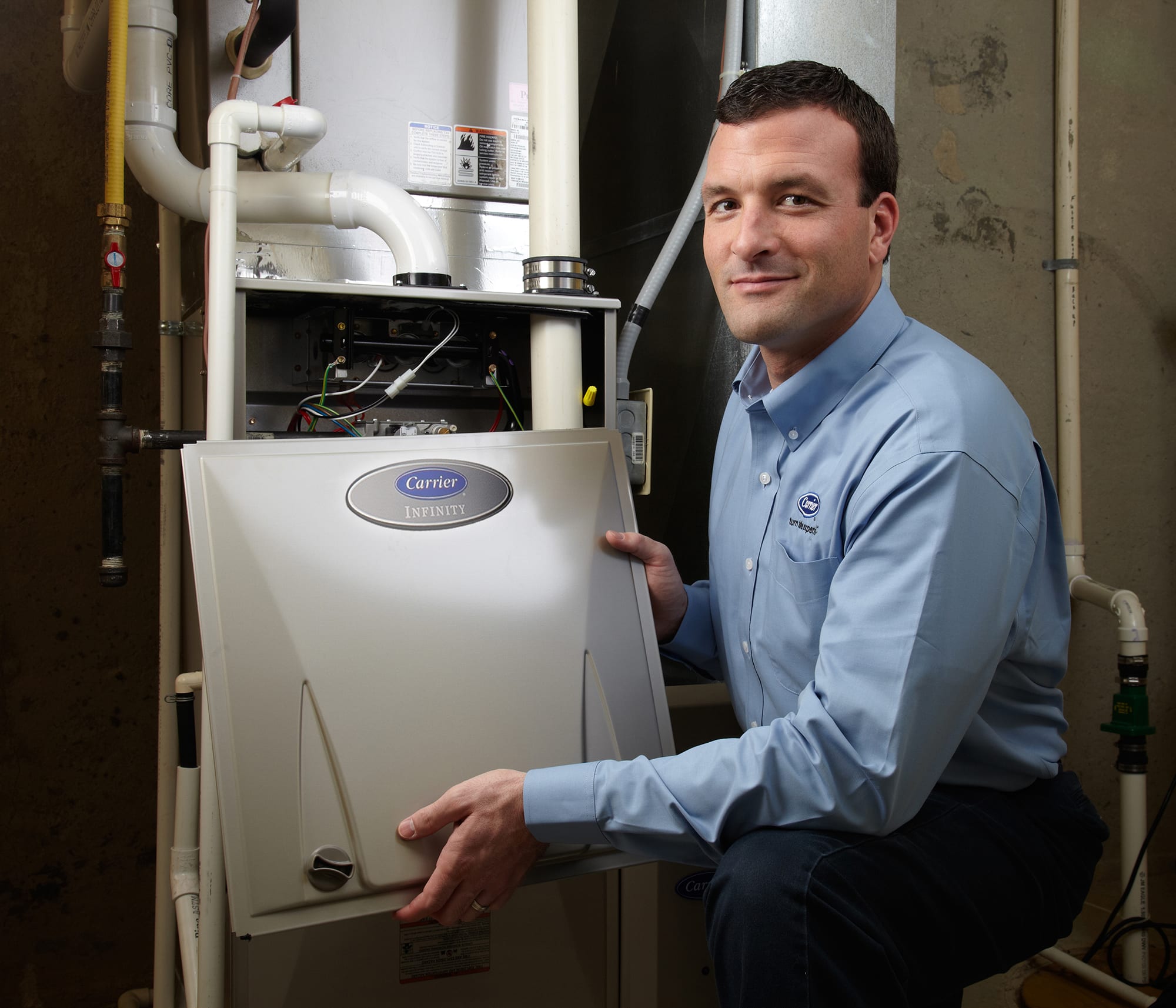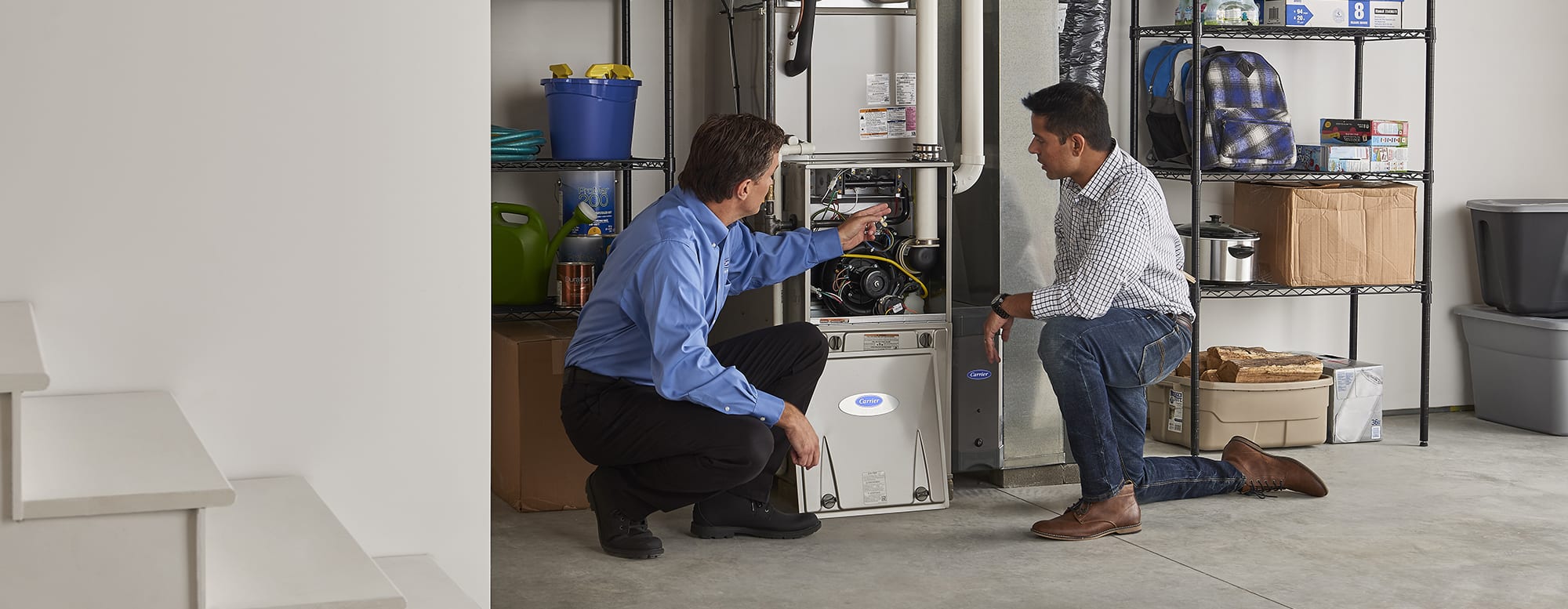How To Clean A Natural Gas Furnace
To maintain your gas furnace and keep it running efficiently, we recommend annual servicing from a trained HVAC professional. At a minimum it should be cleaned at the beginning of each heating season, but repeating mid-year will help keep your gas furnace in peak condition and help prevent future problems.

While cleaning a furnace is not overly complicated, it does offer a number of benefits for the long-term health, efficiency, and reliability of your comfort system.
Most homeowners can take the first step by keeping the air filter cleaned or replaced per the manufacturer's recommendations. While some basic internal cleaning can be performed by just about anybody, properly maintaining the internal components of a furnace, such as the blower or flame sensor will take a little more expertise – the kind that can be offered by your local Carrier expert. Check out our home furnaces web page for a complete look at Carrier furnaces and a breakdown of key components and technologies that help make our heating products exceptional.
HOW TO CLEAN A FURNACE
Understanding how to clean a furnace is important because keeping your system's inside surfaces free from dirt and debris can help extend its performance. For example, dirty buildup on the burners and heat exchanger can reduce the furnace's ability to properly heat your home. Or, a dirty blower can increase the furnace's load and cause increase wear on various components. These and other issues can cause your furnace to work harder can reduce its expected longevity. If you're curious about the question, "How long do furnaces last?" be sure to follow the link to our web page dedicated to life expectancy of today's furnaces.

Preventable issues detrimental to your system's performance can be especially concerning if you've invested in a high-efficiency comfort system with the goal of cutting back on your energy bills. Carrier high efficiency furnaces offer a number of high-end features that perform at their best with periodic maintenance and cleaning.
Among the many components that your Carrier expert will clean include: the blower (also referred to as an "air handler"), the flame sensor, and the coil. Other critical components that can affect performance include the heat exchanger, gas valve, burners, and inducer fan.
Before attempting to clean your furnace, it's always a good idea to shut off power to the unit and also shut off the gas. At this point it will be safe to remove the cabinet doors and begin light cleaning and dust/dirt removal using a small brush, damp cloth, vacuum or compressed air.
HOW TO CLEAN A FURNACE BLOWER
Knowing how to clean a furnace blower isn't just important for heating performance – it can improve the performance your central air conditioning system as well. That's because both use the same blower/air handler to circulate air into and out of the system. To do the job thoroughly, an HVAC professional might start by removing the blower assembly or "squirrel cage" to have better access for both inspecting and cleaning.
Keeping the blower assembly clean can help improve airflow and motor efficiency while reducing the risk for early motor failure. Replacing a blower can be an expensive repair, so keeping it operating at its best can help save money in the long run. And, by keeping the motor housing and blower motor cleaner and more dust-free, you might enjoy improved indoor air quality as well.
HOW TO CLEAN A FURNACE FLAME SENSOR
A furnace flame sensor is very important for safe operation of your furnace. Located on the burner assembly, it looks like a metallic rod. The flame sensor detects the presence of a flame when the gas is on, then shuts down the system if no flame is detected. A dirty flame sensor can cause a disruption of furnace operation, so calling an experienced HVAC technician who knows how to clean a furnace flame sensor can be a boost for safe and reliable operation.
To clean the sensor, your local HVAC professional will turn off the furnace and remove the sensor from the burner assembly. Because the sensor is exposed to flame on a regular basis, it is prone to gritty build-up on its surface which will need to be lightly sanded and wiped off. If performance does not improve after a cleaning, the sensor may need to be replaced.
HOW TO CLEAN FURNACE COILS
When we discuss how to clean furnace coils, we are actually talking about how to clean your evaporator coil. The evaporator coil is attached to your furnace cabinet and is a crucial component for your central air conditioner or heat pump. Keeping it clean will help maintain cooling or heating performance and energy efficiency.
To clean the coil, your HVAC service technician will typically turn off the system and remove the access panel from the coil cabinet. Techniques may vary, but some technicians will apply a "rinseless" coil cleaner spray and follow up with a soft, gentle brush to remove difficult to remove debris.
CONTACT A PROFESSIONAL
While the basics of furnace cleaning are rather simple, getting the job done right can help improve the lifetime and overall performance of your heating and cooling system. That's why we always recommend that you contact a Carrier dealer to get an estimate for your home. Your local Carrier expert can also evaluate your system's performance, make needed repairs, and make recommendations for improved performance.
How To Clean A Natural Gas Furnace
Source: https://www.carrier.com/residential/en/us/products/furnaces/how-to-clean-gas-furnace/
Posted by: gutierrezyouteentron.blogspot.com

0 Response to "How To Clean A Natural Gas Furnace"
Post a Comment